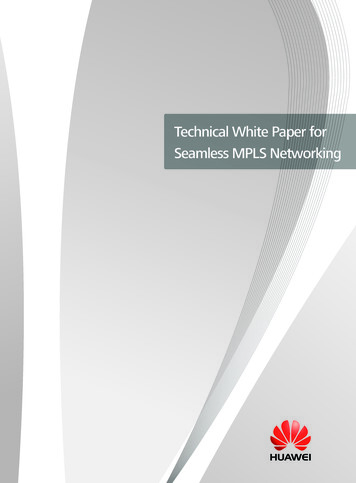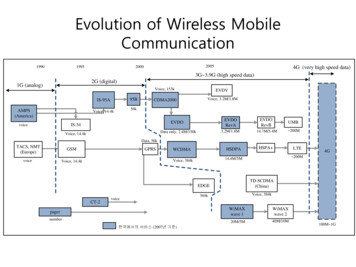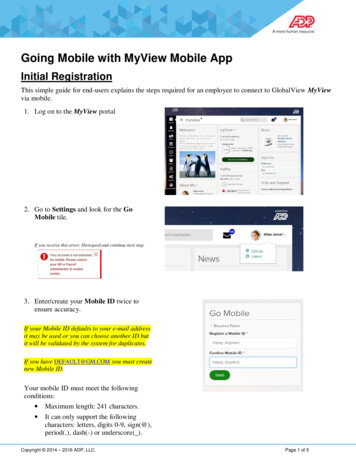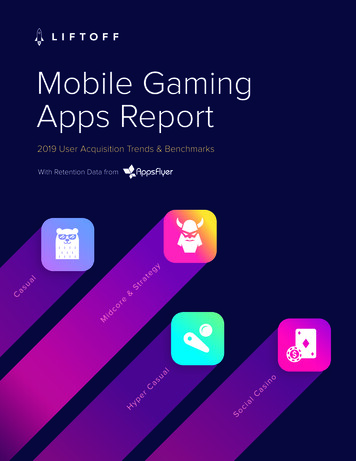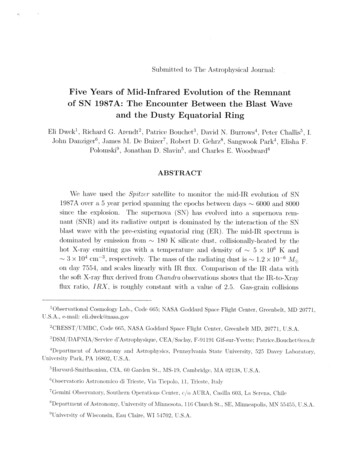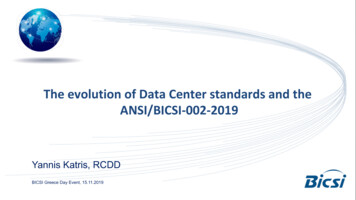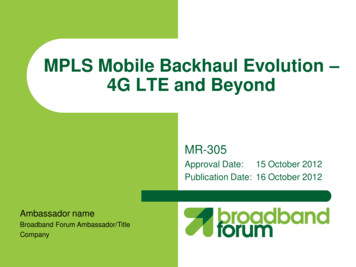
Transcription
MPLS Mobile Backhaul Evolution –4G LTE and BeyondMR-305Approval Date: 15 October 2012Publication Date: 16 October 2012Ambassador nameBroadband Forum Ambassador/TitleCompany
Agenda1.2.3.4.5.6.7.8.9.10.11.12.2Introduction to the Broadband ForumMobile Market OverviewEthernet and IP VPN Backhaul ArchitectureTiming and SynchronizationQuality of Service (QoS) RequirementsResiliency, Protection and PerformanceIPv6 ConsiderationsEnergy EfficiencyRelationship to MEF 22.1Deployment ExamplesBBF Mobile Backhaul Work Plan – 2012Summary
MPLS Mobile Backhaul Evolution TutorialContributors 3Rao Cherukuri – Juniper NetworksDave Christophe – Alcatel-LucentBruno De Troch - Juniper NetworksSharam Hakimi - EXFORichard Gough - EricssonDrew Rexrode – VerizonDave Sinicrope – EricssonKonstantinos Samdanis – NECRami Yaron – DragonWave
Broadband ForumInsert slides from current approvedAmbassador slide deck4
Mobile Market OverviewIssues, trends andenablers of thetransition to IP/MPLSin evolving backhaularchitectures
State of the Market Voice, text messages and data consumption drive majority ofcurrent revenue– Price competitionDeclining average– Reduction or flattening of growth inrevenue per userminutes per subscriber in markets(ARPU)such as North America– Subscribers granted ability to customize phones LTE Deployments– Significantly expand data capacity to enable new devices,services and applications ARPU growth– Initial LTE deployments focus on data services– Focus on enhancing throughput and reducing cost per bit– Increased services for more demanding applications and smartdevices6
Evolution to LTE is all about Services2001200220032004200520062007200820092010 2011,12CDMACDMA20001XCDMA20001xEV-DOEV-DORev ADL: 2.4 MbpsUL: 153 kbpsDL: 3.1 MbpsUL: 1.8 MbpsDL: 153 kbpsUL: 153 kbpsServicesVoiceHigh-speed dataPicture/VideoEmailWeb browsingBroadband dataVOD, ndReal-timeApplicationsWCDMAGSMGPRSDL: 114 kbpsUL: 114 kbpsEDGEDL: 384 kbpsUL: 384 kbpsUMTS (W-CDMA)R99DL: 384 kbpsUL: 384 kbpsTRANSPORTTDM (SONET/SDH, PDH)7FR, HDLC, ATM/IMAEV-DORev BDL: 1.8-7.2 MbpsUL: 384KbpsRequirement:DL: 100 MbpsUL: 50 MbpsDL: 3.1-73 MbpsUL: 1.8-27 vegaming,MultimediaHSDPARel 5LTEMultimedia,VoIP, Video Delivery,Advanced IMSHSUPARel 6DL: 7.2 MbpsUL: 5.2 MbpsHSPA Rel 7HSPA Rel 8Phase 2Phase 1Target:DL: 40 MbpsUL: 10 MbpsIP/EthernetUnifiedIP CentricServiceDeliveryLTERequirement:DL: 100 MbpsUL: 50 Mbps
LTE: All-IP, simplified network architectureWhat is EPC ? New, all-IP mobile core network introduced with LTEEnd-to-end IPClear delineation of control plane and data planeSimplified architecture: flat-IP architecture with a single coreBroadband Forum focusareas for backhaulLTE EPCEvolved Packet Core (EPC)IP channeleNode B(eNB)IP NetworkTransport (backhauland backbone)Evolved Packet Core end-to-end IP transformation of mobile core8
Smart Mobile Devices: Diversity, ExplosionSource: IDC, 201299
Revenue by Technology Most cell sites will support multiple wireless technologies10
Average BW per Installed Connection (Mbps)Traffic Growth — Ethernet to the Rescue100Worldwide Average Bandwidth per Installed Connection(Mbps) 50,000PDH vs Ethernet: Annual Mobile Backhaul Service Charges perConnection90Stay on TDM80 40,0007060 30,0005040 or move toEthernet 20,0003020 10,000100CY08 CY09 CY10 CY11 CY12 CY13 CY14 CY15 CY16New Ethernet wirelineSONET/SDH and WDM 0CY08 CY09CY10 CY11CY12 CY13 CY14CY15 CY16PDH and ATM over PDHPDH and ATM over PDHEthernet wirelineCosts of traffic drive operators to IP/Ethernet backhaul– The “new Ethernet wireline” (Ethernet over fiber or copper, DSL, PON, cable) costssignificantly less per bit than TDM Capacities and charges reflect current planning for HSPA and LTESource: Infonetics Research: Mobile Backhaul Equipment and Services, Market Size, Share, and Forecasts, March 201211
Virtually all New Connections are IP Ethernet1,6001,400Number of New Connections CY14CY15CY16-200-400EthernetTDMOtherIP/Ethernet and LTE mobile backhaul are intertwinedSource: Infonetics Research: Mobile Backhaul Equipment and Services, Market Size, Share, and Forecasts, March 201212
Packet Based Backhaul AdoptionSource: Heavy Reading, June 201213
IP/Ethernet is 94% of 2012 MBH EquipmentSpending — Must Support LTE 9100% 890%80%Revenue (US Billions) 770% 660% 550% 440% 330% 220% 110% 00%CY08CY09CY10IP/Ethernet EquipmentCY11CY12CY13Other EquipmentCY14CY15CY16Ethernet % of total Global 2012 MBHequipment spend will be 7.3 billion– Surge of Ethernet MBHrouters in China caused partof the 2011 bump; return tonormal in 2012 Steady growth after 2012– 8.3B in 2016– Cumulative 39B over 5 years This is very healthygrowth, especially for amarket in the billions ofdollarsSource: Infonetics Research: Mobile Backhaul Equipment and Services, Market Size, Share, and Forecasts, March 201214
Business and Technical Drivers for MobileBackhaul Evolution Mobile backhaul expense is a sizable portion ofoverall Mobile operator OPEX” 4G/LTE capacity and performance is determinedby the size and performance of backhaul network 4G/LTE and small cells impose new requirementson backhaul network Solution needs to support 4G/LTE with the coexistence of 2G and 3G technologies Backhaul has to address network challenges:synchronization, delay, and resiliency15
LTE Deployment Requires Evolution ofBackhaul TransportLTE EPCeNBEvolved Packet Core (EPC)IP channelIP NetworkeNBTransport (backhauland backbone) LTE is built on an all-IP architecture – compared to 3G and previous generations ofmobile technology, it has:– A more direct data and control path between the mobile user and the corenetwork– Base stations (called eNBs) with additional functionality – including directcommunication of client data and control plane traffic between eNBs Transport Implications– Favors more flexible backhaul mesh technology, such as architectures that donot need to transverse the aggregation points– To support transport of latency-sensitive traffic between eNBs, need a backhaularchitecture that minimizes latency– MPLS at the aggregation points is one of the likely solutions to these challenges16
LTE Deployment Requires Evolution ofBackhaul Transport (continued)LTE EPCeNBEvolved Packet Core (EPC)IP channelIP NetworkeNBTransport (backhauland backbone) Flatter IP architecture requires smooth interworking between previously separatemobile backhaul and backbone transport networks– VPN scaling: LTE enabled eNB user plane connects directly to packet-Core– Scope of E2E network planning, traffic engineering, transport SLA monitoringincreases (e.g. high availability, stringent E2E QoS is no longer broken up intosegments with mobile NEs between each)17
LTE RAN ConnectivityaGWBSaGW Star topology enabling communication from BS to aGW(Access Gateway) and from aGW to BS (Base Station). Neighbouring any-to-any topology enablingcommunication among BSs (X2)RAN - Radio Access Network18
Why MPLS? MPLS is THE unifying technology for various backhaultypes MPLS is proven in Service Provider deploymentsglobally – it delivers on its promises MPLS adds carrier-grade capabilities–––––Scalability - millions of users/end pointsResiliency - high availability including rapid restorationManageability – ease of troubleshooting & provisioningTraffic Engineering plus QoS – predictable network behaviorMultiservice – support for 2G (TDM), 3G (ATM, PPP/HDLC and IP),and LTE (IP) and co-existence with other types of traffic e.g.residential– Virtualization – VPNs to ensure separation of OAM fromsignaling / bearer planes, partitioning of multi-operator traffic19
Why IP/MPLS in Mobile Backhaul? Backhaul requires co-existence of multiple transport options–MPLS is a proven mechanism to support ATM, TDM, Ethernet, Frame Relayemulation (Pseudo-wires)– Allows legacy RAN equipment to continue to be utilized (CAPEX protection)while leveraging the advantages of new packet transport networks Packet Backhaul needs to support multi-media traffic– Voice/VoIP, Video/Multimedia, SMS, Data– MPLS –TE enables advanced QoS capability– Improved network utilization, Better ROI Reliability is critical– MPLS offers faster convergence and interoperable mechanisms for failuredetection and recovery Backhaul is increasingly becoming a strategic asset– MPLS at cell site enabled carriers to offer new revenue generating services(i.e. L2/L3 nageabilityTE/QOS
Multi-phase MPLS migration into RAN TransportPhase 1Radio Access NetworkCell Site2G – TDM/IP3G – ATM/IPLTE – Enet, rATMT1/E1CopperPPPT1/E1CopperTDM ATM PPP EnetSDH/SONETFiberAggregationviaSDH/SONETTDM ATM PPP Enet wave (PDH channels)Separate transmissionfacilities for differenttechnologiesIP/MPLS BackboneBSC RNC WACTDM/IP ATM/IP EnetConvergedIP/MPLSBackboneTDM ATM PPP Enet wave (SDH ch)ATMAggregationOverlayCentral Aggregation,Consolidation,Service RoutingMPLS “edge”21
Multi-phase MPLS migration into RAN TransportPhase 2Radio Access NetworkCell Site2G – TDM/IP3G – ATM/IPLTE – Enet, erPPPT1/E1CopperTDM ATM PPP Enet wave (PDH channels)Separate transmissionfacilities for differenttechnologiesMPLSAggregationfor allTechnologiesTDM ATM PPP EnetMPLSSDH/SONETfiberTDM ATM PPP EnetMPLSEthernetfiberTDM ATM PPP EnetMPLSEthernet ch waveCommon facility forall trafficMPLS “edge”22IP/MPLS BackboneMTSOBSC RNC WACTDM/IP ATM/IP EnetCentral Aggregation,Consolidation,Service RoutingConvergedIP/MPLSBackbone
Multi-phase MPLS migration into RAN TransportPhase 3Cell SiteMPLSAggregationfor allTechnologiesRadio Access NetworkTDM ATM Enet IPMPLSSDH/SONETfiberTDM ATM EnetMPLSEthernetfiberIPTDM ATM EnetMPLSEthernet ch waveIPHubMPLSAggregationfor allTechnologiesTDM ATM EnetMPLSSDH/SONETfiberTDM ATM EnetMPLSEthernetfiberIP/MPLS BackboneMTSOBSC RNC WACTDM/IP ATM/IP Enet2G – TDM/IP3G – ATM/IPLTE – Enet, IPCommon facility forall trafficTDM ATM EnetMPLSEthernet ch waveRouterCommon facility forall trafficMPLS “edge”MPLS is agnostic to transmission techniques in Access23ConvergedIP/MPLSBackbone
Mobile Backhaul Standards Landscape 3GPP– RAN definition and specification – definition of the RAN and its interfaces Broadband Forum– TR-221 – architecture of mobile backhaul transport support with MPLS– TR-221 Amd-1 (work in progress) – scaling and resiliency of the mobilebackhaul network (for example small cell deployment)– WT-145 – next generation broadband network architecture to supportmobile backhaul– Certification – certification of MPLS technologies to support mobilebackhaul transport– Tutorials – education on MPLS in mobile backhaul transport MEF– MEF-22.1 – Metro Ethernet services and interfaces required to supportmobile backhaul– Mobile Backhaul Whitepapers and Tutorial ITU-T SG 15– Specification for Clock Synchronization over packet network24
What is MMBI?MPLS in Mobile Backhaul (MMBI) MPLS in Mobile Backhaul (MMBI) is a technical initiative started in2007 by the IP/MPLS Forum and adopted by the BroadbandForum The initiative currently consists of– Architecture and nodal requirements specifications– Test specifications– Certification programs related to mobile backhaul (e.g., TDMover MPLS)– Whitepapers– Tutorials (such as this one) There are currently 7 specifications More specifications are in progress to address mobile backhaul ofLTE and beyond.25
What MMBI aims to address? Faster mobile broadband deployment– HSPA/HSPA /LTE/LTE-A Supporting 4G/LTE-Advanced features Enhanced experience for mobile users with new dataservices and application, along with voice– Location based service, VoIP, gaming, etc Future-proof investments Improve mobile operator’s bottom line and simplifyoperations26– Converging technology specific backhaul networks to singlemulti-service packet infrastructure– Based on proven benefits of IP/MPLS while leveraging costbenefits of Ethernet
MMBI Reference ArchitectureAccessBSAggregationCell SiteGatewayCoreMobileAggregationSite GatewayAbisRC /MME /S-GWTDM TNLEdgeNodeIubATM ne,GPON,Optical EthAccessNodeEdgeNodeAbisATM TNLIubEdgeNodeEdgeNodeIPTNLHDLCTNLBase StationNode-BBase Station ControllerRNCCircuit Edge devicesMSCPacket Edge devices SGSN, GGSN27Iu-CSIu-PSIurMPLS transport networkWCDMA/UMTSS5/S8APDN GWGbAbisIu-PSSGSN 2GSGSN 3GMPLS PE function could be integrated intothe BS (BTS/Node S1MSC 2GMSC 3GIu-CSS5/S8AAggregation networkAbisHDLCTNLTDM TNLAAGbCDMA2000/1xLTEBTSBSCMSCPDSNeNBS-GW / MME
Ethernet and IP VPN BackhaulArchitecture
IP TNL with L2VPN (Transport Network Layer)29VPLS - Virtual Private LAN ServiceH-VPLS - Hierarchical Virtual Private LAN ServiceVPWS - Virtual Private Wire Service
VPLS (Access & Aggregation)PEMPLS(VPLS)PEEthernet linkBidirectional PWVSI instanceS-GWPEPESwitch SiteVirtual Switching Instance (VSI) per Cell Site: 30Network is made up of many VPLS instances (3 nodes in each)LSP-based protection is mandatory (from all flavours of MPLS)Protection against a node failure at the switch site (PE or Router)VRRP runs between the switch site routers
VPLS and VLANPWLSPSwitch SiteS-VLANIPEthernet linkBidirectional PWC-VLAN fromcell sites31S C VLAN inPB domainS-Tag is stripped at ingressside of PES-Tag is put back egressside of PEVSI instance
VPWS (Access & Aggregation)PEMPLS(VPWS)PEEthernet linkActive PWStandby PWS-GWPEPESwitch SitePW Redundancy group per Cell Site: 32Network is made up of many VPWS instancesLSP-based protection is mandatory (from all flavours of MPLS)Protection against a node failure at the switch site (PE or Router)PW Redundancy runs in Independent mode from each Cell Site
VPWS and LSPSwitch SiteS-VLANIPEthernet linkC-VLAN fromcell sites33S C VLAN inPB domainS-Tag is stripped at ingressside of PES-Tag is put back egressside of PEActive PWStandby PW
IP TNL with L3VPN (Transport Network Layer)34
L3VPN (Access & Aggregation)PEMPLS(L3VPN)PES-GWEthernet linkVRF instanceVRF connectivityPEPESwitch SiteMultiple VPN Routing and Forwarding (VRF) instances: 35One VRF for RAN management traffic (security)One VRF for all other RAN traffic (CDMA, 2G, 3G, LTE)Single IP address space for the RAN no further VRFs necessarySingle or Multiple Autonomous System (AS) options for scalability
IP TNL Using L2 & L3 (Transport Network Layer)36
L3VPN and EthernetPEEthernetMPLS(L3VPN)PES-GWPESwitch SiteC-VLANC-VLAN fromcell sitesS-VLANS C VLAN inPB domainVRFS-Tag is stripped at ingressside of PEVRF terminated in theswitch site routerEthernet linkVRF connectvity37IPLSPVRF instance
Timing and Synchronization
The Need for Synchronization in Mobile NetworksRNCRNCNobeB1: Radio FramingAccuracyMobile CoreNetwork(s)NodeBeNB or BS2 : HandoffControleNB or BSaGW3 : BackhaulTransport Reliability Synchronization is vital across many elements in themobile network In the Radio Access Network (RAN), the need isfocused in three principal areas39
Radio Framing Accuracy In Time Division Duplexing (TDD), the base station clocks must betime synchronized to ensure no overlap of their transmissions withinthe TDD frames– Ensuring synchronization allows for tighter accuracies and reducedguard-bands to ensure high bandwidth utilization In Frequency Division Duplexing (FDD) the centre frequencies mustbe accurate for receivers to lock40
Radio Framing AccuracyFrequency SynchronizationRadio Frequency Accuracy LTE TDD/FDD: 50 ppb LTE – A TDD/FDD: 50 ppbTA 1/fAAtTB 1/fBBRadio Phase/ToD Accuracy LTE TDD: /-1.5 μs LTE-A with eICIC/CoMP: /-1.5 - 5 μstfA fBPhase SynchronizationTA 1/fAAToD – Time of DayeICIC - Enhanced inter-cell interference coordinationCoMP - Coordinated multiple point41TB 1/fBBfA fB
Handoff Control For Reliable Mobility Performance Synchronization is vital to ensure service continuity(i.e. successful handoff) Studies have shown significant reduction in call drops whengood synchronization is in place; enhanced QoE42
Backhaul Transport ReliabilityBackhaul networkeNB/BS/NodeB/BTSXaGW/RNC/BSCTCP end-to-end windowed transmission Wander and Jitter in the Backhaul and Aggregation Network cancause underflows and overflows Slips in the PDH framing will cause bit errors leading to packetrejections Packet rejections lead to retransmissions and major perceptibleslow down in TCP windowed sessions43
Timing Distribution Methods External Timing Source–GPS Physical layer clock– Using synchronous TDM interfaces, e.g. PDH/SDH– Using synchronous Ethernet as per G.8261/G.8262, andG.8264 for ESMC/SSM Physical Timing distribution over packet network––––IEEE 1588-2008 / ITU G.8265NTPAdaptive Clock RecoveryDifferential Clock Multiple methods might be deployed in a networkNote: Both GPS and IEEE1588-2008 support frequency and phase, there is ITU-T workin progress on the telecom profiles for phase/Time of Day support44
Quality of Service RequirementsQuality of Service (QoS)capabilities of MPLSmobile backhaul networks
Quality of Service Requirements Supports QoS and service level agreements Uses IETF DiffServ Architecture (RFC 2475) Supports at least 4 CoS and associated service metrics (e.g.,delay, delay variation, packet loss). Supports Connection Admission Control to guarantee sufficientbandwidth is available to support new connections conformingto all SLAs. SLAs are enforced using functions such as policing/shaping,marking and hierarchical scheduling. Supports the pipe model of RFC 3270. Supports both E-LSPsand L-LSPs. Supports mapping between the QoS of the TNL and TC bits ofthe LSP labels.46
Resiliency, Protection andPerformanceOperations,Administration andManagement (OAM) andResiliency
OAM Requirements OAM needed for reactive & proactive networkmaintenance– Quick detection and localization of a defect– Proactive connectivity verification and performancemonitoring OAM tools have a cost and revenue impact tocarriers– Reduce troubleshooting time and therefore reduceOPEX– Enable delivery of high-margin premium serviceswhich require a short restoration time Top level requirements– Provide/co-ordinate OAM at relevant levels inIP/MPLS network– Proactive and reactive mechanisms, independent at alllevels48SOAM – Service OANVCCV - Virtual Circuit Connectivity VerificationService Levele.g. Eth SOAM, L3 VPNPW Levele.g. VCCV, PW statusTunnel LSP Levele.g. LSP ping
Service and Transport OAM Service and Transport OAM rely on the same set ofprotocols Service OAM is a service-oriented mechanism thatoperate and manages end-to-end service– IP/MPLS VPN service OAM and PM IP and VRF ping and trace route BFD PM based on RFC 6374– Ethernet Service OAM and PM 802.1ag Connectivity Fault Management (CFM) ITU-T Y.1731 PM for Ethernet services Transport OAM is a network-oriented mechanismand manages the network infrastruture.– IP/MPLS VPN service OAM and PM (PerformanceMonitoring) BFD (Bidirectional Forwarding Detection) LSP ping and traceroute PW – VCCV and Status49
Service-Aware OAM ToolkitCell Site2GBTSPseudowiresNode B4GService Levele.g ATM OAM, SDP-PingMPLS AggregationMPLSAccess3GPW Levele.g BFD, VCCV, PW statusTunnel LSPHubeNB, BSMTSOTunnel / LSP Levele.g LSP Ping & TracerouteQuickly isolate and troubleshoot faults to reduce MTTRTool set for reactive & proactive network operation and maintenance Defect detection, proactive connectivity verification, and performance monitoring Provide/co-ordinate OAM at relevant levels in IP/MPLS network–Services Level: Eth SOAM, ATM OAM, IP/MPLS VPN Service OAM–Tunnel LSP Level
3 MPLS Mobile Backhaul Evolution Tutorial Contributors Rao Cherukuri – Juniper Networks Dave Christophe – Alcatel-Lucent Bruno De Troch - Juniper Networks Sharam Hakimi - EXFO Richard Gough - Ericsson Drew Rexrode – Verizon Dave Sinicrope – Eri

